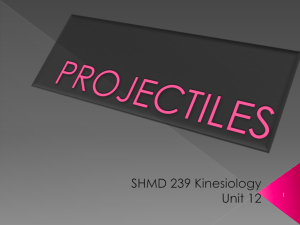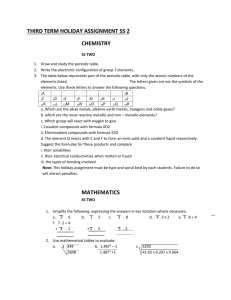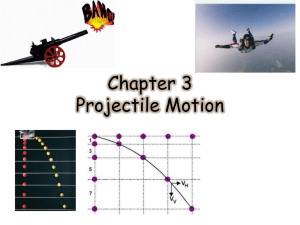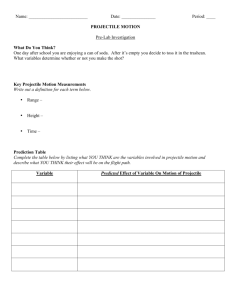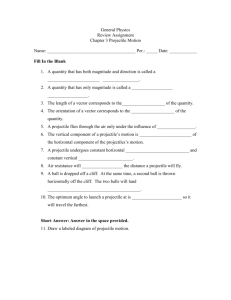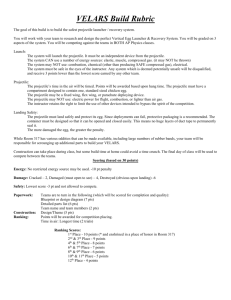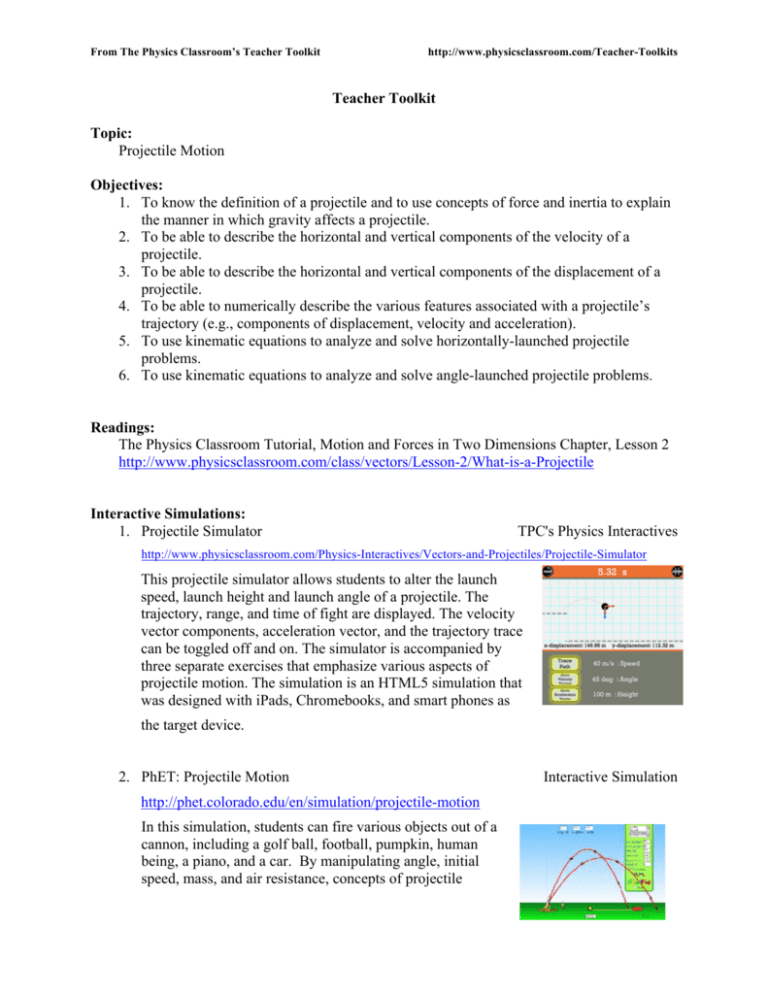
From The Physics Classroom’s Teacher Toolkit
http://www.physicsclassroom.com/Teacher-Toolkits
Teacher Toolkit
Topic:
Projectile Motion
Objectives:
1. To know the definition of a projectile and to use concepts of force and inertia to explain
the manner in which gravity affects a projectile.
2. To be able to describe the horizontal and vertical components of the velocity of a
projectile.
3. To be able to describe the horizontal and vertical components of the displacement of a
projectile.
4. To be able to numerically describe the various features associated with a projectile’s
trajectory (e.g., components of displacement, velocity and acceleration).
5. To use kinematic equations to analyze and solve horizontally-launched projectile
problems.
6. To use kinematic equations to analyze and solve angle-launched projectile problems.
Readings:
The Physics Classroom Tutorial, Motion and Forces in Two Dimensions Chapter, Lesson 2
http://www.physicsclassroom.com/class/vectors/Lesson-2/What-is-a-Projectile
Interactive Simulations:
1. Projectile Simulator
TPC's Physics Interactives
http://www.physicsclassroom.com/Physics-Interactives/Vectors-and-Projectiles/Projectile-Simulator
This projectile simulator allows students to alter the launch
speed, launch height and launch angle of a projectile. The
trajectory, range, and time of fight are displayed. The velocity
vector components, acceleration vector, and the trajectory trace
can be toggled off and on. The simulator is accompanied by
three separate exercises that emphasize various aspects of
projectile motion. The simulation is an HTML5 simulation that
was designed with iPads, Chromebooks, and smart phones as
the target device.
2. PhET: Projectile Motion
http://phet.colorado.edu/en/simulation/projectile-motion
In this simulation, students can fire various objects out of a
cannon, including a golf ball, football, pumpkin, human
being, a piano, and a car. By manipulating angle, initial
speed, mass, and air resistance, concepts of projectile
Interactive Simulation
motion come to light in a fun and game-like environment. Can you set the initial
conditions so that you hit the target? Teachers: For a unique activity to accompany this
simulation, here’s a Problem-Based Learning exercise developed by a high school
teacher. Learners take the role of a military artillery officer with the task of explaining
factors that affect the path of a projectile fired from a cannon. The lesson is aimed at
beginners as they explore variables affecting trajectory.
Projectile Motion Simulation: Problem-Based Learning Investigation
3. Projectile Motion with Angry Birds
Interactive Simulation
http://www.compadre.org/OSP/items/detail.cfm?ID=11562
This resource uses the free Tracker Video Analysis tool to
measure and analyze the motion of an angry bird projected
from a slingshot to hit a pig. If you don’t have Tracker yet,
here’s a link to the free download: Download Tracker Video
Analysis and Modeling Tool
Authored by Anne Cox 4. Projectile Motion: Galileo and Newton Simulation
Interactive Simulation
http://www.opensourcephysics.org/items/detail.cfm?ID=12169
In the mood to try something different? This
unique resource models two views of projectile
motion. The Galileo version describes projectile
motion as a combination of horizontal motion
with a constant velocity, equal to the projectile
initial horizontal velocity component, and
vertical motion with constant acceleration and an
initial velocity equal to the projectile's initial
velocity component. The second view, described by Newton in his Principia presents
projectile motion as a combination of inertial motion, with constant velocity equal to the
projectile's initial velocity and motion produced by a constant downward acceleration
starting from rest. These two views are mathematically equivalent, but each emphasizes
different aspects of the motion.
©The Physics Classroom, All Rights Reserved
This document should NOT appear on other websites.
Video and Animation:
1. Physlet Physics: Projectile Motion Illustration
Warm-Up Exercise
http://www.compadre.org/Physlets/mechanics/illustration3_4.cfm
This animation was designed to help beginners form
correct conceptual understanding of projectile motion.
It will help students visualize an object's motion in the
x and y directions separately, which is key to solving
projectile motion problems. Authored by Aaron Titus,
a well-known and respected developer of simulations
for physics education.
2. Physlet Physics: Uphill and Downhill Projectile Motion
Simulation-Based Problems
http://www.compadre.org/Physlets/mechanics/ex3_5.cfm
This simulation with accompanying problem set would be
ideal for a digital lab on projectile motion. The worksheet
was crafted to help learners stay focused on specific
questions limited in scope to launch angle and initial speed.
It's a solid way to introduce learners to projectile motion
without overwhelming them with too many variables.
3. Physlet Physics: The Projectile and the Lamborghini
Simulation-Based Problem
http://www.compadre.org/Physlets/mechanics/prob3_10.cfm
Here's a fun, short activity that presents a projectile
aimed at a moving car. You can change the projectile's
launch angle and initial speed by using the text boxes
and clicking "set values and play." The task: find the
relationship between v0 and θ such that the projectile
will always hit the car.
©The Physics Classroom, All Rights Reserved
This document should NOT appear on other websites.
Labs and Investigations:
1. The Physics Classroom, The Laboratory, Basketball Analysis
Students use video analysis to investigate the horizontal and vertical velocity and
acceleration of a basketball.
2. The Physics Classroom, The Laboratory, Projectile Simulation
Students use an online simulation to investigate the motion parameters of a projectile at
a variety of locations along its trajectory.
3. The Physics Classroom, The Laboratory, Projectile Problem-Solving
Students use an online application to master three types of horizontally-launched
projectile problems. Students input answers and receive immediate feedback.
4. The Physics Classroom, The Laboratory, Launcher Speed
Students fire a projectile launcher horizontally from a table top and make measurements
in order to determine the launch speed of the projectile launcher.
5. The Physics Classroom, The Laboratory, Maximum Range
Students use a projectile launcher to experimentally determine which angle projects a
launched ball the furthest.
6. The Physics Classroom, The Laboratory, Hit the Target
Students use a calibrated projectile launcher (from Lab 4: Launcher Speed above) and
predict the initial height a target a known distance away must have in order for the
launched projectile to strike the target.
Link: http://www.physicsclassroom.com/lab#vp
Demonstration Ideas:
1. MIT Tech TV: Monkey and a Gun Video Demonstration
https://www.youtube.com/watch?v=cxvsHNRXLjw
It’s the classic scenario of "Monkey and the
Hunter". A stuffed monkey is suspended from a
rod. A golf-ball gun is aimed directly at the
monkey. The demo is designed so the monkey
begins falling precisely when the gun fires the
golf ball. The projectile and target meet in mid
air. Teachers: Intuitively, your students may
think that the hunter needs to aim below the
monkey due to the high speed of the projectile.
They will reason, "If you shoot at the monkey, won’t the bullet whiz over its head as the
monkey falls? But that's wrong. Once the bullet exits the gun, there’s only one force
acting on it with any significance: gravity (and some negligible air resistance in this
case). Likewise, only gravity will act upon the monkey after he loosens his grasp."
©The Physics Classroom, All Rights Reserved
This document should NOT appear on other websites.
2. Ball Drop
The Physics Classroom's YouTube Channel
https://www.youtube.com/watch?v=qY8bACj1Mac
This 90-second video demonstrates and explains why a ball launched
upward from a platform moving at a constant speed will fall back onto
the platform. This demonstration is based on a classic question in
physics: if a heavy package is released from the cargo pit of a plane that
is flying at a constant speed, where will the package land when it hits
the ground – under the plane, behind the plane, or in front of the plane?
If the equipment is not available to perform the demonstration, then this
video would be an effective alternative.
3. Upward Launch
The Physics Classroom's YouTube Channel
https://www.youtube.com/watch?v=0W7xhn5KLUI
This 90-second video demonstrates and explains why a ball
released from above a platform moving at a constant speed will
land onto the platform. The demonstration is based on a classic
question in physics: If a ball is projected vertically from the bed
of a pick-up truck moving at a constant speed, where will the
ball land when it falls back to the ground? If the equipment is not
available to perform the demonstration, this video would be an
effective alternative.
Minds On Physics Internet Modules:
The Minds On Physics Internet Modules are a collection of interactive questioning modules
that target a student’s conceptual understanding. Each question is accompanied by detailed
help that addresses the various components of the question.
1. Vectors and Projectiles, Ass’t VP7 - The Nature of a Projectile
2. Vectors and Projectiles, Ass’t VP8 - The Acceleration and Velocity of a Projectile
3. Vectors and Projectiles, Ass’t VP9 - Velocity Components for a Projectile
4. Vectors and Projectiles, Ass’t VP10 - Displacement and Time
Link: http://www.physicsclassroom.com/mop
©The Physics Classroom, All Rights Reserved
This document should NOT appear on other websites.
Interactive Homework Problems
1. Illinois PER Interactive Examples: Projectile
Interactive Digital Problem
http://per.physics.illinois.edu/per/IE/ie.pl?phys111/ie/02/IE_projectile
This problem requires the student to determine the distance a
projectile will travel when thrown off a cliff with a given initial
velocity. It provides explicit help in differentiating the vertical
and horizontal components of motion, then determining the
correct application of formulas. The problem is accompanied
by a sequence of questions designed to encourage critical
thinking and conceptual analysis before dealing with the
mathematics.
2. Illinois PER Interactive Examples: Arrow
Interactive Digital Problem
http://per.physics.illinois.edu/per/IE/ie.pl?phys111/ie/02/IE_arrow
This interactive problem will help learners understand why
we deal with kinematic equations for both components of
motion in the example of an arrow shot from a bow. Given
initial velocity and distance traveled by the arrow, how
much time does it take to reach the target? The author
provides a detailed conceptual analysis of how to examine
the horizontal component of motion (caused by the archer) and the vertical component
(caused by gravity). To keep things simple, the problem assumes no air resistance.
3. Illinois PER Interactive Examples: Thrown Ball
Interactive Digital Problem
http://per.physics.illinois.edu/per/IE/ie.pl?phys111/ie/02/IE_thrown_ball
Two boys, at a distance 63 meters apart, are playing
catch. Given the initial speed and angle of projection
of the thrown ball, how far must the catcher move to
intercept the ball? A user-activated "help" sequence
is provided for each step of the problem-solving,
from conceptual analysis through quantitative
calculation. Immediate feedback is received for both correct and incorrect responses.
Concept Building Exercises:
1. The Curriculum Corner, Vectors and Projectiles, Projectile Motion
Link: http://www.physicsclassroom.com/curriculum/vectors
Problem-Solving Exercises:
1. The Calculator Pad, Vectors and Projectiles, Problems #21 - #34
©The Physics Classroom, All Rights Reserved
This document should NOT appear on other websites.
Link: http://www.physicsclassroom.com/calcpad/vecproj
Science Reasoning Activities:
1. Science Reasoning Center, Vectors and Projectiles, Up and Down
2. Science Reasoning Center, Vectors and Projectiles, Maximum Range of a Projectile
3. Science Reasoning Center, Vectors and Projectiles, Juggling
Link: http://www.physicsclassroom.com/reasoning/projectiles
Real Life Connections:
1. Problem-Based Learning: Murder You Solve
Group Learning Activity
http://pbl.ccdmd.qc.ca/resultat.php?action=clicFiche&he=1050&afficheRecherche=99&IDFiche=140&endroitRetour=99&lesMotsCles=murder%20you%20solve
Students take the role of a crime scene
investigator as they explore firearm ballistics to
solve a homicide. The scenario involves the case
of a young man slain in his own apartment with
a handgun. Students must use the ballistic data
available to determine whi ch suspect is the
shooter. True to the PBL method, learners will
separate useful from irrelevant data, then
collaborate to apply physics to solve the case.
Includes a printable student manual. The Instructor's Guide (with teaching tips and
solutions) requires a password, accessible at no cost to registered teacher-users.
Common Misconceptions
1. Horizontal Launches vs. Vertical Drops from the Same Height
A common question that quickly uncovers a misconception is "If a ball is released from
rest at the same time and from the same height that a second ball is launched
horizontally, then which ball will strike the ground first." Quite surprising to students,
the answer is that the balls strike the ground at the same time. Imparting an initial
horizontal velocity to the second ball has no affect on its vertical motion. Perpendicular
components of motion are independent of each other. The misconception uncovered by
the leading question is that the two components of motion somehow depend upon one
another. In students' minds, the changing of a horizontal parameter affects the vertical
motion.
2. Horizontal Velocity Decreases with Time
By definition, a projectile is an object upon which the only force is gravity. Gravity,
being a vertical force, can only affect the vertical motion of a projectile. As such, the
horizontal motion obtained at launch time does not change over the course of the
motion. In the absence of horizontal forces, there is no horizontal acceleration for a
projectile. The presence of air resistance would cause a launched object to decrease its
horizontal velocity; but introducing air resistance into the discussion changes the topic
from projectile motion to non-projectile motion.
©The Physics Classroom, All Rights Reserved
This document should NOT appear on other websites.
Elsewhere on the Web:
1. Dot Physics: Could the Black Arrow Actually Kill a Dragon?
http://www.wired.com/2014/11/black-arrow-actually-kill-dragon/
If you and your students liked The Desolation of
Smaug, you'll be delighted with this exploration
by physics teacher Rhett Allain. He asks the
question, "Could the black arrow actually kill a
dragon?" Then he takes a deep dive into the
physics of the situation. He took a video clip
from the trailer that shows a dwarf shooting a
Black Arrow. "It shows just enough frames with the arrow in it for me to get a plot of the
position." Dr. Allain was able to plot both the horizontal and vertical position of the end
of the arrow as it is shot from the ballista. He uses data from this graph, plus his own
experimental data, to make a claim. Do you agree with his conclusion?
©The Physics Classroom, All Rights Reserved
This document should NOT appear on other websites.
Standards:
A. Next Generation Science Standards (NGSS) – Grades 9-12
Disciplinary Core Ideas
• HS-PS2.1.i Newton’s second law accurately predicts changes in the motion of
macroscopic objects
Performance Expectations
• HS-PS2-1 Analyze data to support the claim that Newton’s second law of motion
describes the mathematical relationship among the net force on a macroscopic object, its
mass, and its acceleration
Crosscutting Concepts
Scale, Proportion, and Quantity
• Algebraic thinking is used to examine scientific data and predict the effect of a change
in one variable on another
Systems and System Models
• When investigating or describing a system, the boundaries and initial conditions of the
system need to be defined.
Science and Engineering Practices
Practice #1: Analyzing and Interpreting Data
• Analyze data using computational models in order to make valid and reliable scientific
claims.
Practice #2: Developing and Using Models
• Develop and use a model based on evidence to illustrate the relationships between
systems or between components of a system.
• Use a model to provide mechanistic accounts of phenomena.
Practice #6: Obtaining, Evaluating, and Communicating Information
• Communicate scientific ideas (e.g. about phenomena and/or process of development
and design of a proposed system) in multiple formats, including orally, graphically,
textually, and mathematically.
Practice #8: Using Mathematics and Computational Thinking
• Use mathematical representations of phenomena to support claims.
• Use mathematical representations of phenomena to describe explanations.
• Create or revise a computational model or simulation of a phenomenon, designed
device, process, or system.
B. Common Core Standards for Mathematics (CC) – Grades 9-12
Standards for Mathematical Practice:
• Reason abstractly and quantitatively
• Model with mathematics
• Look for and express regularity in repeated reasoning
©The Physics Classroom, All Rights Reserved
This document should NOT appear on other websites.
High School: Number and Quantity – Vector and Matrix Quantities
• N-VM.1 Recognize vector quantities as having both magnitude and direction.
Represent vector quantities by directed line segments and use appropriate symbols for
vectors and their magnitudes.
• N-VM.2 Find the components of a vector.
High School: Algebra – Reasoning with Equations and Inequalities
• A-REI.4.b Solve quadratic equations by inspection (e.g., for x squared = 49), taking
square roots, completing the square, the quadratic formula, and factoring, as
appropriate to the initial form of the equation.
• A-REI.10 Understand that the graph of an equation in two variables is the set of all
its solutions plotted in the coordinate plane, often forming a curve.
High School: Functions – Interpreting Functions
• F-IF.4 For a function that models a relationship between two quantities, interpret key
features of graphs and tables in terms of the quantities, and sketch graphs showing key
features given a verbal description of the relationship.
• F-IF.6 Calculate and interpret the average rate of change of a function (presented
symbolically or as a table) over a specified interval. Estimate the rate of change from a
graph.
High School: Functions – Trigonometric Functions
• Use special triangles to determine geometrically the values of sine, cosine, tangent.
C. Common Core Standards for English/Language Arts (ELA) – Grades 9-12
Reading Standards for Literacy in Science and Technical Subjects
Key Ideas and Details
• RST.9-10.2 Determine the central ideas or conclusions of a text; trace the text’s
explanation or depiction of a complex process, phenomenon, or concept; provide an
accurate summary of the text.
• RST.9-10.3 Follow precisely a complex multistep procedure when carrying out
experiments, taking measurements, or performing technical tasks, attending to special
cases or exceptions defined in the text.
Craft and Structure
• RST.11-12.4 Determine the meaning of symbols, key terms, and other domainspecific words and phrases as they are used in a specific scientific or technical context
relevant to grades 11-12 texts and topics.
Integration of Knowledge and Ideas
• RST.11-12.7 Integrate and evaluate multiple sources of information presented in
diverse formats and media in order to address a question or solve a problem.
• RST.11-12.8 Evaluate the hypotheses, data, analysis, and conclusions in a science or
technical text, verifying the data when possible and corroborating or challenging
conclusions with other sources of information.
©The Physics Classroom, All Rights Reserved
This document should NOT appear on other websites.
• RST.11-12.9 Synthesize information from a range of sources (e.g., texts, experiments,
simulations) into a coherent understanding of a process, phenomenon, or concept,
resolving conflicting information when possible.)
Range of Reading and Level of Text Complexity
• RST-9-10.10 By the end of Grade 10, read and comprehend science/technical texts in
the grades 9-10 text complexity band independently and proficiently.
©The Physics Classroom, All Rights Reserved
This document should NOT appear on other websites.



